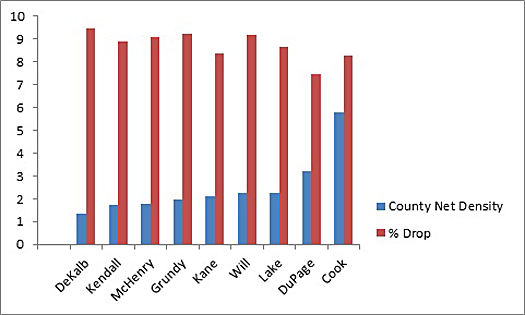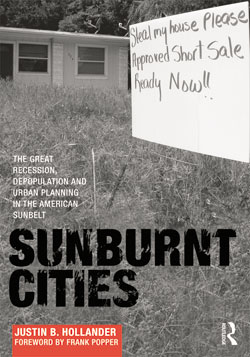A Placemaking Journal
Urban Happiness Index, Expanded
Hazel Borys’ ideas on the Healthy Places Index yesterday brought to mind some of my own thoughts on the matter — thoughts in excess of what might reasonably be tolerated in the comments section. Thanks to PlaceMakers for providing me the opportunity to share them here.
On Saturday at a used bookstore, I picked up Robert Burton’s The Anatomy of Melancholy, written in 1620. Tudor Publishing in New York released the translation from Latin by Floyd Dell and Paul Jordan-Smith in 1927.
While mostly focused on what we’d call the psychology of melancholy and happiness, it’s full of wonderful homilies on diet, exercise, and the “digression of air.” From pages 446-447:
“The Country hath his recreations, the City his several Gymnicks and Exercises. May-games, Feasts, Wakes and Merry Meetings, to solace themselves, the very being in the Country … how have they been pleased with it, to prune, plant, inoculate, and graft, to shew so many several kinds of Pears, Apples, Plums, Peaches & etc …
“Every Palace, every City almost, hath his peculiar Walks, Cloisters, Terraces, Groves, Theatres, Pageants, Games, and several Recreations…”
Burton continues with lists of the virtues of the City for seventeen pages. Interesting notes comparing city designs and their apparent observed relation to the quality of “air” across Europe, Africa, and Asia Minor, including street width and what we’d call solar access on pages 434-438 and, again, within the section on Exercise.
Not your usual study! But it is still timely and pertinent, and plenty of fun to go hunting down in your own walkable neighborhood on a Saturday afternoon.
I’d also add to the list the Journal of Happiness Studies. It’s a serious periodical on the scientific understanding of subjective well-being. “Contributions span a broad range of disciplines: alpha-sciences, philosophy in particular; beta-sciences, especially health related quality-of-life research; and gamma-sciences, including not only psychology and sociology but also economics.”
Toward a Social Report from the ‘60s, is in many ways the first modern attempt at a comprehensive national indicators study.
One way of coming at the Urban Happiness Index is to look objectively at where people want to live and what they are willing to pay for it.
On that basis, Americans live overwhelmingly in metropolitan regions, and are willing to pay more than what it costs to live elsewhere.
Looking at trends, the emerging turnaround in urban demand by leading demographic groups – namely Baby Boomers and Millenials – shows increasingly that demand is either for central city or older suburb, both of which cost more than the alternatives, and that exurban construction is slowing way, way down.
Here’s a graph of the drop in construction permits issued September Year to Date, 2005 versus 2012, by county in the Chicago MSA, from data I just downloaded via the Census Bureau’s Building Permits Survey.

County net density is the average density of block groups for all block groups in each county, based on 2005-2009 American Community Survey data, calculated by us here at CNT for the Housing + Transportation Affordability Index. Percent Drop is the absolute drop, which I’ve divided by 10 to make it easier to read.
Generally, the higher the net density, which is our proxy here for “urban,” the lower the drop in construction activity throughout the recession. This is for 1-4 unit permits only, so I could tighten this up by doing a weighted average of single and multi-family permits, but you get the idea.
Cook County is where Chicago is located, and by definition where all of the “first ring” suburbs are located. DuPage is the second most populous and much wealthier per household. Lake County, north of Cook County and along the lakefront, is mostly quite wealthy and very transit-oriented. There are cities in Kane County (Aurora and Elgin) and in Will Count (Joliet), which became part of metropolitan Chicago through sprawl.
All six of the lowest density places have scored high at one time or another on various “fastest growing counties” indexes, but not any longer. Most of the suburban foreclosure hot spots we’ve tracked are in these lowest density and formerly “fastest growing” places.
We can do a similar analysis for all regions, and with little exception we should get the same pattern. The point is that people are again voting with their feet—only this time relocating from exurbia to someplace more secure, namely cities.
We should think further about what other indicators of (dis)satisfaction-induced behavior we could identify in close to real time.
Last week, CNU released a report on Philadelphia housing prices by University of Pennsylvania economist Kevin Gillen. It’s called The Correlates of Housing Price Changes with Geography, Density, Design and Use. Gillen’s report uses different methods to get at similar conclusions to my quick Chicago analysis, finding much more stabile home prices in walkable, urban neighborhoods versus exurban, auto-centric locales.

This trend has been documented for a while now, such as in Justin Hollander’s book, Sunburnt Cities, published by Routledge in 2011. People could argue that sunbelt outcomes are biased, because things are more dynamic in fast-growing places. The data isn’t just an artifact of newer sunbelt / sunburnt cities, but similar outcomes are seen in Philadelphia, Chicago, and Boston. These are points of satisfaction because people value their properties and are holding onto them.
You can’t argue that all the wealthy people are moving to the cool places. Instead, we’re finding that walkable, livable, happiness-generating places are increasing in value, and in turn enriching those who live there, monetarily and otherwise.
Check out the entire Urban Happiness Series here.
–Scott Bernstein
Scott is President and CEO of The Center for Neighborhood Technology (CNT). The CNT is the national non-profit that has pioneered ways to quantify the advantages of linking transportation, land use and housing strategies with economic development and community affordability. It is the leading national provider of web-based analytic and data access tools for local area planning intended to meet the triple bottom line of improved quality of life, improved economic quality of place, and environmental resilience. CNT is a winner of the 2009 MacArthur Foundation Award for Creative and Effective Institutions, and Planetizen lists Scott Bernstein as number 27 in its poll identifying the Top 100 Urban Thinkers of the past century.






